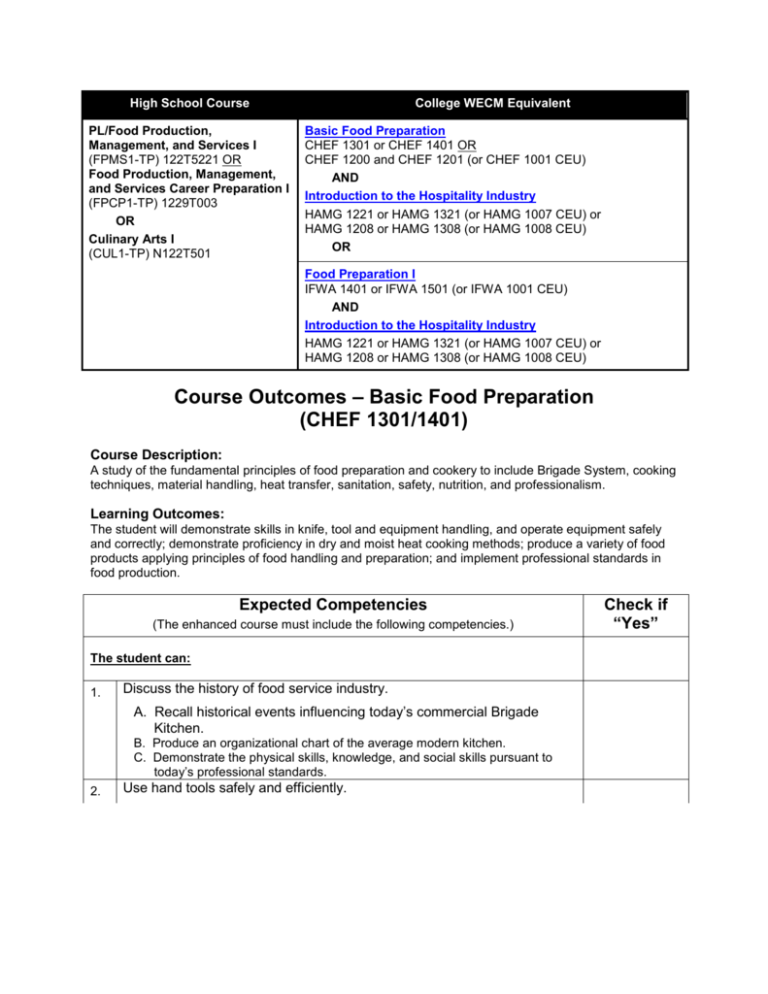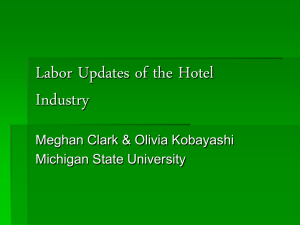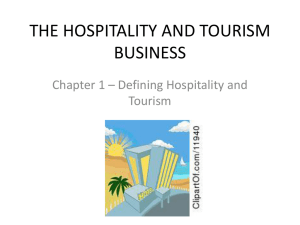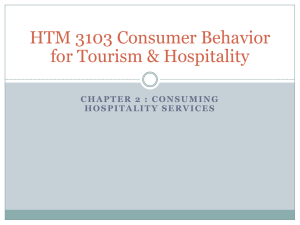College Course Outcomes
advertisement

High School Course PL/Food Production, Management, and Services I (FPMS1-TP) 122T5221 OR Food Production, Management, and Services Career Preparation I (FPCP1-TP) 1229T003 OR Culinary Arts I (CUL1-TP) N122T501 College WECM Equivalent Basic Food Preparation CHEF 1301 or CHEF 1401 OR CHEF 1200 and CHEF 1201 (or CHEF 1001 CEU) AND Introduction to the Hospitality Industry HAMG 1221 or HAMG 1321 (or HAMG 1007 CEU) or HAMG 1208 or HAMG 1308 (or HAMG 1008 CEU) OR Food Preparation I IFWA 1401 or IFWA 1501 (or IFWA 1001 CEU) AND Introduction to the Hospitality Industry HAMG 1221 or HAMG 1321 (or HAMG 1007 CEU) or HAMG 1208 or HAMG 1308 (or HAMG 1008 CEU) Course Outcomes – Basic Food Preparation (CHEF 1301/1401) Course Description: A study of the fundamental principles of food preparation and cookery to include Brigade System, cooking techniques, material handling, heat transfer, sanitation, safety, nutrition, and professionalism. Learning Outcomes: The student will demonstrate skills in knife, tool and equipment handling, and operate equipment safely and correctly; demonstrate proficiency in dry and moist heat cooking methods; produce a variety of food products applying principles of food handling and preparation; and implement professional standards in food production. Expected Competencies (The enhanced course must include the following competencies.) The student can: 1. Discuss the history of food service industry. A. Recall historical events influencing today’s commercial Brigade Kitchen. B. Produce an organizational chart of the average modern kitchen. C. Demonstrate the physical skills, knowledge, and social skills pursuant to today’s professional standards. 2. Use hand tools safely and efficiently. Check if “Yes” Expected Competencies (The enhanced course must include the following competencies.) A. Recognize standard knives/measuring devices/hand tools and cooking vessels. B. Discuss the composition and function of standard knives/measuring devices/hand tools and cooking vessels. C. Perform daily maintenance on knives/measuring devices/hand tools and cooking vessels. D. Perform multiple cutting techniques with a selection of common kitchen cutlery. 3. Demonstrate knowledge of basic cooking principles. A. Name the components of various foods and discuss the changes that take place during their cooking. B. Describe heat transfer as it applies to various foods. C. Describe the differences between dry and moist heat cooking methods. D. Apply dry and moist cooking methods in the lab. E. Recognize and describe major herbs and spices. F. Discuss the concepts and basic principles of proper seasoning. 4. Demonstrate proficiency of recipe structure and uses. A. List the structure and functions of a standardized recipe. B. Define the terminology of a recipe. C. State the intricate relationship between recipes – weights and measures – and effective cost control. D. Define the equivalences among standard weighing and measuring devices. E. Convert between standard measures to weights. F. Properly weigh and measure common kitchen ingredients. G. Increase or decrease a recipe to a desired yield. H. Calculate the total cost of a recipe and the cost per portion of a recipe. 5. Demonstrate an understanding in dealing with sauces. A. B. C. D. E. Define three basic components of a sauce. Prepare thickening agents. Prepare stocks. Incorporate seasonings and flavor ingredients. Perform finishing techniques on various sauces. F. Define and recognize the five mother sauces. G. Define and classify small sauces. 6. 7. Describe the elements of soup preparation. A. Describe the major categories of soup. B. Prepare soups from each category. C. Describe techniques used to serve soups. Demonstrate knowledge of vegetable categories and various cooking techniques for each. A. List the categories of vegetables and identify examples of each category. 8. B. Describe the physical changes that occur to vegetables during various cooking techniques. C. List the most favorable cooking techniques for various vegetables. Demonstrate knowledge of potatoes, rice, and pasta categories and various cooking techniques for each. Check if “Yes” Expected Competencies (The enhanced course must include the following competencies.) A. B. C. D. List the categories of potatoes and identify examples of each. Select the appropriate types of potatoes for various cooking techniques. List and describe the types and categories of rice. Prepare different types of potatoes, pasta, and grain using various cooking techniques. 9. Discuss the variety of salad types and determine their appropriate use. A. Select and prepare salad ingredients for use. B. Discuss the categories (production methods, types of ingredients) of salads. C. Assemble salads from each salad category. D. Define the three categories of salad dressings. E. Prepare salad dressings from each category. 10. Define the categories of milk and egg products and describe their characteristics. A. Identify the components of an egg and describe their reactions to various food production techniques. B. List the components of cheese and describe the transformations that occur during the processing. C. Define the varieties of cheese and list examples from each variety. D. Prepare recipes that incorporate milk, cheese, and egg products. Textbook, Hardware/Software, and Tool Recommendations: None. Check if “Yes” Course Outcomes – Introduction to the Hospitality Industry (HAMG 1221/1321) Course Description: Introduction to the elements of the hospitality industry. Learning Outcomes: The student will explain the elements of the hospitality industry; discuss current issues facing food service; discuss current guest needs; and explain general hotel/motel operations. The student will explain and discuss the role of service in the hospitality industry. Expected Competencies (The enhanced course must include the following competencies.) The student can: 11. Describe the scope of the travel and tourism industry, and identify the types of businesses it includes. Explain why people travel, and identify internal and external factors that influence their travel choices. List five categories of requirements for tourist destination, and give examples of each. Explain the economic impact of tourism on the international, national, and local levels, and define the term “globalization.” Using the 1991 tourist destination data given in the text, identify the top six destination states in the United States and the number one destination in the world. Describe the Unites States’ status as a tourism spender and earner, and cite evidence of Unites States’ recovery from its long-term tourism gap. Identify the major influence on foreign travel to the United States. Identify three possible negative impacts of tourism, and define the term “ecotourism.” Identify the three levels of employment in lodging operations and give examples of each. Give examples of some of the considerations involved in deciding where to start a lodging career. Describe types of careers in the food service operations. 12. Describe educational and training opportunities in the hospitality industry. 13. 18. Summarize the demands and rewards of working in the hospitality industry. Trace the origins of the European lodging industry, and describe the role of the grand tour. Characterize the transit, vacation, and the grand hotel type that were produced in the first move toward “market segmentation” in Europe. Outline the pre-1900 history of US hotels, and identify the origins of the first-class hotel. Identify two turn-of-the-century developments that significantly affected the lodging industry, and relate the contributions of Ellsworth Statler. Briefly explain how the Great Depression affected the hospitality industry. 19. Describe the status of the hospitality industry during World War II and the 1940s. 1. 2. 3. 4. 5. 6. 7. 8. 9. 10. 14. 15. 16. 17. Check if “Yes” Expected Competencies (The enhanced course must include the following competencies.) 20. 21. 22. 23. Describe the motel and motor hotel boom and it’s effect on the hotel industry. Trace the origins of the American resort, and characterize the four basic resort types. Cite reasons for the growth of international resorts. 37. Summarize the history of Caribbean hotels. Distinguish between independents and chains, and identify the advantages and disadvantages of each type of operation. Compare condominium and timesharing ownership. Distinguish between franchise agreements and management contracts and identify the chief advantage of each. Describe the impact of market segmentation on the hotel industry and list some of the market segmentations. Describe the role of amenities have played in the lodging since 1980. Identify the most common applications of advanced technology in the hotel industry and explain the major motivations behind technological innovations in the 1990s. Identify modern business management procedures that have changed the hotel industry. Identify the major factors behind lodging industry growth in the 1980s and describe some of the results of that growth. Define consolidation and conversion and explain their importance to the lodging industry. Describe the course globalization has taken in the hotel industry and identify some of the major issues in globalization. Describe current trends in the international lodging industry with regard to Europe, Hawaii, and Asia and the Pacific Rim, Mexico, and the Caribbean. Describe the size and scope of the lodging industry. Identify nine American hotel classifications and the primary market segments they attract. Describe European hotel market segments and hotel types. 38. Describe the overall organization of an American hotel. 39. Explain the primary responsibilities of the major hotel divisions. A. Rooms. B. Food and beverage. C. Engineering and maintenance. D. Marketing and sales. E. Accounting. F. Human resources. G. Security. Describe the overall organization of a European hotel. 24. 25. 26. 27. 28. 29. 30. 31. 32. 33. 34. 35. 36. 40. 41. 44. Explain the importance of cooperation in a lodging operation. Describe how a lodging operation interacts with the guests, suppliers, and the community, and the governmental agencies. Name the five departments of the rooms division, and indicate why the division is important. Describe the primary responsibilities of the front office. 45. Summarize the functions of cashier section, including the night audit. 46. Summarize the functions of the mail and information section. 42. 43. Check if “Yes” Expected Competencies (The enhanced course must include the following competencies.) 49. Identify typical reservations department activities, and describe types of reservations. Identify the duties of the telephone department and explain how advanced technology helps this department run more smoothly. Describe the responsibilities of the uniformed staff. 50. Trace the origins of the restaurant. 51. Describe the early development of food service in the United States. 52. Identify the basic European menu types. 53. Describe the development of modern food service operations in the United States. 54. Note differences between European and American food service operations. 55. Describe the nature and scope of franchising in the food service industry. 56. 59. Identify characteristics of a successful food service franchise operation. Identify some of the problems and concerns that can arise in a franchising relationship. Discuss the trend toward using management companies in institutional food service operations. Differentiate commercial from institutional and military food service operations. 60. List and briefly describe the market classifications of food service operations. 61. 63. Describe the development of hotel food and beverage operations. Identify and describe the functions of the five primary departments of a large hotel food and beverage chain. Compare the organizational structures of large and small restaurants. 64. List the main objectives of food service in hotels. 65. Identify and define key elements of success in food service. 66. 75. List and explain the six food service subsystems or control points. Explain the importance of a good beverage department, and summarize its operation. Identify current concerns in promoting beverage sales, and provide some suggestions. Describe the job of a food and beverage controller. Explain how food and beverage cost information is obtained, and define prime cost. List possible causes of excessive payroll costs and suggest ways of controlling costs. Describe the increase in the engineering division’s responsibilities and the importance of effective management. Summarize the engineering division’s responsibilities for the five major hotel systems. Explain the importance of proper maintenance, and describe preventive maintenance procedures. Suggest some common reasons for carrying out major renovations. 76. Explain the engineering division’s role in good water management. 77. Identify major causes of problems in energy management, and list some solutions. 78. Describe energy management programs and their benefits. 79. Identify environmental concerns that may arise in the development or expansion of 47. 48. 57. 58. 62. 67. 68. 69. 70. 71. 72. 73. 74. Check if “Yes” Expected Competencies (The enhanced course must include the following competencies.) 81. a hotel. Define marketing, market, market segment, market mix, and marketing mix, and explain the difference between marketing products and marketing services. Identify the components and goals of a feasibility study. 82. Detail the steps and functions of a situation analysis. 83. Describe the marketing planning process and its basic components. 84. Describe the organization of the marketing and sales division. 85. Identify the various ways marketing brings guests to a property. Identify the similarities in the marketing and sales strategies of the hotel and airline industries. Describe the business of selling hospitality products and services, and differentiate between internal selling and personal selling. Explain the importance of rating systems in the hospitality industry. 80. 86. 87. 88. 89. 90. 91. 92. 93. 94. 95. 96. 97. 98. 99. 100. 101. 102. 103. 104. 105. 106. 107. Identify the advantages and disadvantages of six advertising media. Explain the purpose of special promotions, and differentiate between publicity and public relations. Summarize the importance of accounting. Identify internal and external users of accounting information. Explain the purpose of the generally accepted accounting principles, and cite those principles hospitality managers should know. Describe the advantages of following a uniform system of accounts. Explain the purpose or function of basic accounting tools. A. Operating budgets. B. Income statements. C. Balance sheets. D. Ratio analysis procedures. Relate the use of managerial accounting techniques to planning and control decisions. Identify and describe the three categories of activities that constitute the routine work of the accounting division. Summarize the responsibilities of the purchasing department. Describe the human resources division’s contribution to management functions, and list the components of its mission. Describe traditional and innovative recruiting techniques used in the hospitality industry. Describe and explain the human resources division’s role in the employee selection process. Summarize the human resources division’s duties in overseeing employee wages, salaries, and benefits. Explain the importance of the turnover problem in the hospitality industry and how it effects the duties of the human resources division. List the components of a well-designed orientation program, and discuss current trends in training and development. Explain the role of the human resources division in employee relations, employee relocation, discipline, and termination. Describe what the human resources division can do to promote increased productivity. Identify the major record keeping functions of the human resources division. Check if “Yes” Expected Competencies (The enhanced course must include the following competencies.) 108. 112. Explain the goals of quality assurance programs. Describe some of the problems international expansion poses for hospitality businesses. Explain the increased interest in security in the hospitality industry and the broad aims of the security division. Summarize significant aspects of security in the hospitality industry, including its property-wide importance, the security manager’s duties, and the components of a sound security program. Describe the components of physical security. 113. Identify some of the special security responsibilities of major hotel divisions. 114. Describe the guest’s role in security. 115. Describe the extent and kinds of employee theft. 116. Explain the use of inventory, key, and other controls. Identify and describe ways that a property may encourage a team approach to safety. 109. 110. 111. 117. Check if “Yes” Textbook, Hardware/Software, and Tool Recommendations: Lattin, Gerald W. The Lodging and Food Service Industry, 4th edition. American Hotel and Motel Association. Course Outcomes – Food Preparation I (IFWA 1401/1501) Course Description: Introduction to the elements of the hospitality industry. Learning Outcomes: The student will explain the elements of the hospitality industry; discuss current issues facing food service; discuss current guest needs; and explain general hotel/motel operations. The student will explain and discuss the role of service in the hospitality industry. Standardized competencies currently do not exist for this course.






